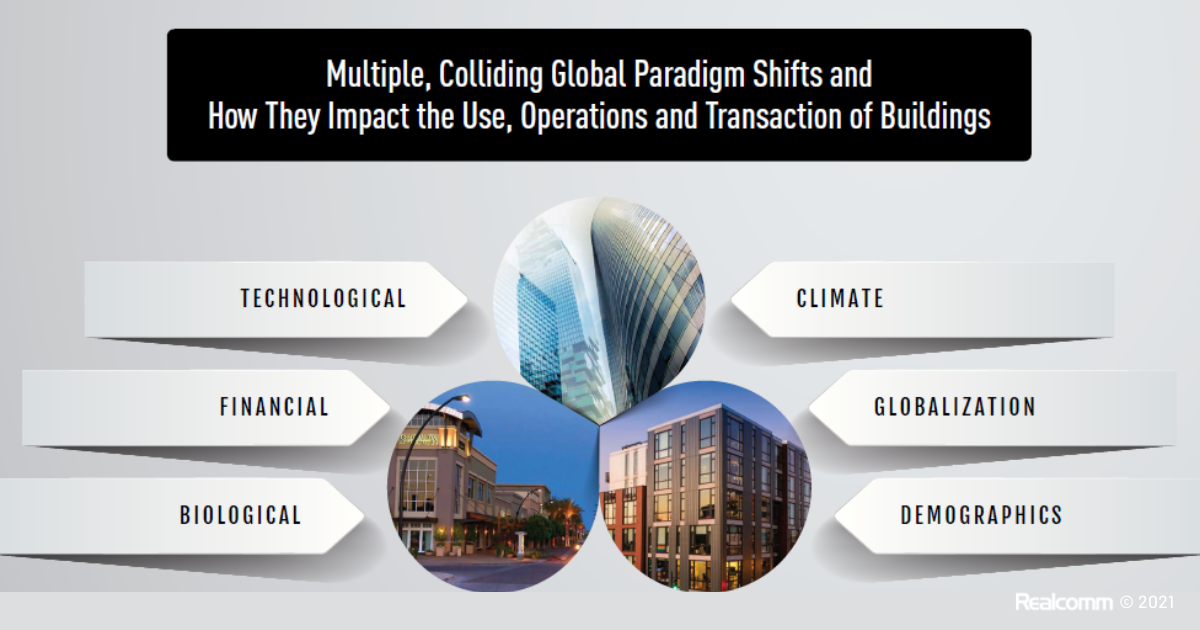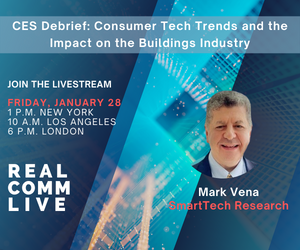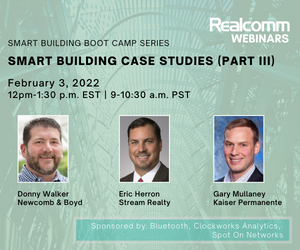6 Colliding Paradigms Converging on the Built Environment

The primary function of commercial and corporate real estate is to facilitate the socio-economic needs of society. During the agrarian age, barns were prevalent; the industrial age brought us factories; and for the last 50-75 years we have built office, industrial, retail, multifamily and other forms of real estate required to meet our economic and lifestyle needs. This coincided with Henry Fordís vision of allowing humans to transport themselves wherever they wanted to go. Live here, drive to work, go to the mall then back home.
Over the last 30 years, we've seen major technological advances that allowed us to do things never before imagined. Buy a song, watch a movie, participate in a video conference, shop for anything and everything - all of which used to require us to get in a car and go somewhere. But not anymore. This fundamental shift started with the laptop and was accelerated with a standard network called the Internet.
There is no doubt that this technological paradigm shift continues and in fact, is accelerating. What most people donít realize is that it is only one of six major shifts taking place at the same time. Following are the six major paradigms that will impact the built environment for many years to come.
Technology
We have already mentioned the historical technology that has gotten us to this point, but what about the technology to come? Quantum Computing, 6G, Nanotechnology, Artificial Intelligence, Blockchain, Cryptocurrency, NFTs, Autonomous Vehicles, AR/VR/XR, the Metaverse, the Internet of Things (IoT), Robotics, 3D Printing, and more that are all poised to create advanced computing concepts which will impact our daily lives in significant ways. As immersive experiences get better and more realistic, what happens to the office, shopping, going to concerts or the movies? All of these have a direct impact on how we use physical space and will put enormous pressure on buildings owners and operators to make sure their buildings are 21st century ready.
Financial
The traditional financial system is currently a combination of analog (paper dollars) and digital systems and processes (credit cards, EFTs, ACHs, etc.). The move to digital is driven by speed, convenience and security. There have been several real estate assets impacted by this transformation. From the ATM lobby to the bank branch and central office, the digitization of financial transactions continues to impact how we use space in the financial world and this is just the beginning. Blockchain, digital wallets, cryptocurrencies, NFTs, and other emerging financial technologies are poised to further disrupt financial structures and the real estate that goes along with them. Will server farms and cryptocurrency mining networks built into the sides of mountains impact the value of skyscrapers in New York that house our largest banks and financial institutions? We must also be ready for the systemic disruptions these technologies will have on real estate transactions and valuations.
Biological
COVID-19, a microscopic particle of a virus that originated halfway around the world, has had a profound impact on how we have used buildings over the last 24 months. Not only do building occupants require new technologies to offer up a new level of health, safety and wellness, but they are also questioning how much they need those offices at all. The pandemic has also brought to light an important but much ignored topic of biowarfare. Once only the subject of Hollywood movies and conspiracy theorists, biowarfare is now considered a potential threat to life going forward, especially life inside buildings. Large gatherings or crowds are usually the targets of those hoping to disrupt because it is more efficient and effective. That means smaller, distributed groups have a much greater chance of success against these threats. Office buildings, malls, sporting events, concerts, and any large participant venues must be aware of and prepared for these types of threats. While we have not seen biowarfare as a commonplace occurrence, building owners and operators need to add this to their ever-growing list of risk management concerns. Finally, even though the bio risks are critical, the most important question that the pandemic raised and must be answered is, in the future, to what extent will we need and use space.
Climate
While the climate concern has been an ongoing conversation for the past 20 years, it seems that we are finally at a point where mainstream companies are taking it seriously. Even if you cannot come to terms with all the data behind the apocalyptic prognostications, almost everyone can agree that spewing carbon into the atmosphere makes no sense. If we are going to make a significant impact and reverse the current trajectory of climate change, we are going to have to face some uncomfortable realities when it comes to buildings. The two-hour commute isnít feasible. Buying goods from halfway around the world and having them shipped to your door one by one, every day, is not good for the planet. Office buildings with pre-pandemic utilization of only 35%, dropping to 10% during the pandemic but still requiring heating, cooling and lighting (in some cases 24 hours a day, 7 days a week) needs to be addressed. Buildings are 40-45% of the overall energy consumption and unless serious reconfiguration of business patterns and utilization of technology is radically adopted, the climate change battle will be lost.
Globalization
As of January 2022, there are approximately 7.8 billion people on the earth. Most of the new inhabitants, thanks to the Internet, now know much more about the world than past generations. With a quick search on Google, people are being exposed to a fast-paced culture taking place in urban areas around the world. This is setting expectations for lifestyles never before seen. In many respects, this means more buildings and lots of them. However, with energy, sustainability and climate concerns, the world cannot simply deliver this lifestyle to all 7.8 billion people. We would need 10 planet earths of natural resources and a burnt-out atmosphere to meet the demand. There is no other choice for building developers and operators but to continue to find new ways and new technologies to deliver these experiences without putting continued pressure on the planet. Next generation broadband, wireless, IoT, and other technologies will be necessary to make buildings 21st century ready. Big and dumb buildings are out, and small and smart buildings are in. Finally, those with global portfolios will need to consider different cultures' positions on privacy. For example, a building in China with advanced facial recognition and tenant tracking would not be well received in a more privacy sensitive country in the West.
Demographics
For this conversation, demographics for the most part will deal with age. With longer life expectancy, we are seeing more and more people make use of our buildings and facilities. As these buildings become more technology-centric we will need to deal with the fact that different generations embrace technology with varying levels of expertise and enthusiasm. The young generations who have grown up with technology have come to expect a certain amount of convenience, speed and efficiency that is delivered through automation. If a building is going to have a lifespan of 50+ years, it will need to go through various technology upgrades to remain relevant. Also, as the pandemic has shown us all too well, working, learning, playing and shopping can now all be done, to a certain extent, remotely using technology. What we have experienced with Teams and Zoom for work and Amazon for shopping is only the beginning of what is called immersive experiences. The younger generations who will soon be running the world are all very comfortable with new ideas and will embrace them quickly. There is more than one reason why Microsoft recently bought Activision, one of the worldís biggest gaming companies. While the boomers may not understand the World of Warcraft, the new future leaders are going to be more comfortable doing things virtually. Building owners and operators need to come to terms that these new tenants will be embracing concepts and technologies like the Metaverse. To be more attractive to a new generation of tenants, buildings will have to be technology ready more than ever.
These colliding paradigms are powerful on their own, so just imagine what it means with six happening all at the same time. These trends will not just impact buildings, but life as we know it. In the future, to save the planet while better managing our time, weíll take advantage of new technologies and do things like annual physical exams from our bedroom connected to a new kind of healthcare provider. What will this mean to healthcare facilities that continue to work in analog ways? This is just one example of thousands of ways technology will impact how we use and operate space. What we are seeing is not a typical 10-year cycle but rather major tectonic shifts. Barns, factories, office, industrial, retail... what's next? I think we will find out once these paradigm shifts have begun to settle in. These paradigms are very complex and will require much discussion and debate to fully understand the impact on the built environment in the future.
This Week’s Sponsor
Planon is the leading global provider of Real Estate and Facility Management software that enables building and service digitalization by integrating the diverse landscape of smart building technology, business solutions and data into one source of truth and turning that into value for building owners, building users, and service providers. www.planon.com
Read Next
 5/29/2025
5/29/2025
AI Canít Fix Bad Data. These Ideas Can Get You on the Right Track. Real estate visionaries constantly integrate innovative technology to make their organizations more efficient.
 5/22/2025
5/22/2025
Managing Building Automation and Integration Like an Investment Portfolio What if your building automation and integration decisions were managed with the same precision, discipline, and long-term vision as Warren Buffettís investment portfolio?
 5/15/2025
5/15/2025
Tech, Talent and Transformation: 2025 Digie Finalists Announced For 27 years, Realcomm has presented the Digie Awards to acknowledge companies, real estate projects, technologies, and individuals that have advanced the commercial real estate industry through the strategic use of technology, automation, and innovation.
 5/15/2025
5/15/2025
Empowering Space Management with Data-Driven Visualization For effective CRE space management, itís critical to centralize lease data, maximize rental square footage (RSF), improve energy efficiency and reconfigure spaces to meet changing needs.


%20(1)%20(1)%20(1).png)










